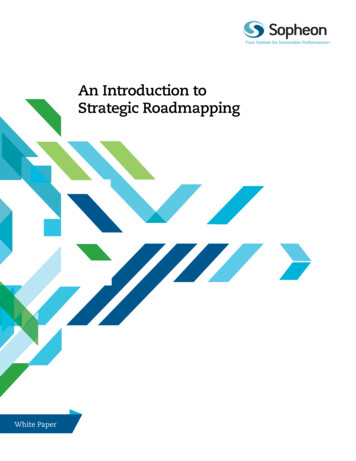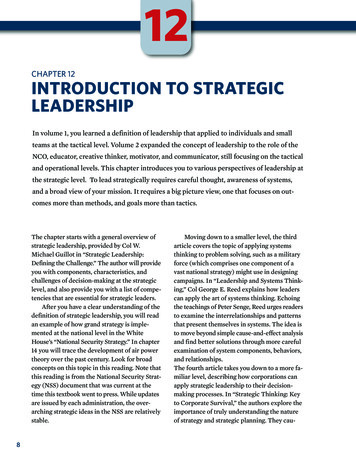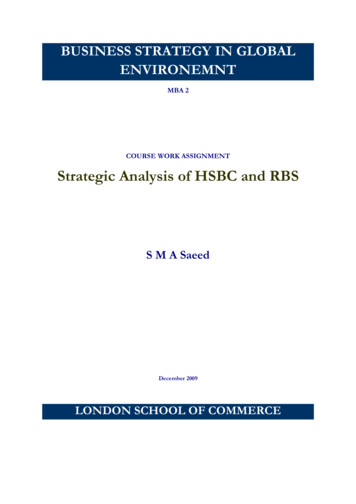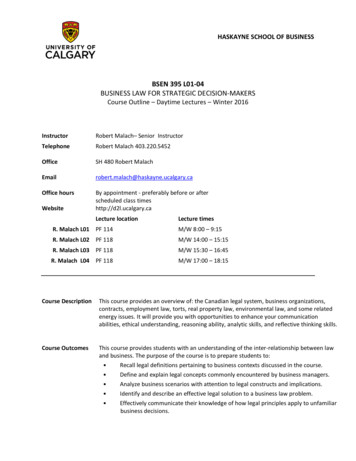
Transcription
An Introduction toStrategic RoadmappingWhite Paper
An Introduction to Strategic RoadmappingAn Introduction to Strategic Roadmapping .3What is Roadmapping? .3Why Engage in Roadmapping?.3Strategic Roadmapping 101 .3Benefits of Strategic Roadmapping .4Roadmapping as a Business Process .4Market Roadmaps.5Product Roadmaps .5Technology Roadmaps.5Composite Roadmaps .6Strategy Alignment .6Roadmapping in the Real World – Use Case Scenarios .6Develop a Cross-Functional, Integrated Strategy withRoadmapping.7Roadmapping with Software .7Take the Next Step Towards Enterprise-Wide StrategyAlignment .9Sources .10About Sopheon .102
An Introduction to Strategic RoadmappingAn Introduction to Strategic RoadmappingWhat is Roadmapping?Roadmapping is the discipline that drives improved decision making by integrating enterpriseinformation from across functions into a set of integrated and interdependent plans used todirect strategies for innovation, product development, technology advances, and operations/supply chain throughout an entire organization.Roadmapping allows the organization to clearly communicate plans to enable a focus on fewer,bigger and better products that provide the best return on innovation investment. As a strategicplanning process it increases transparency, making it easier to model future scenarios withmultiple resource investment opportunities. Executives go beyond “gut feeling” and are trulyinformed decision makers who can view alternatives, perform “what-if” analysis and proceedwith the best course of action.80% of executivessay they have a gapbetween strategy andproduct developmentactivity.1Gartner ResearchWhy Engage in Roadmapping?Roadmapping is essential for business and strategic alignment across an organization.According to Gartner Research, 80% of corporate executives recognize that they have a gapbetween strategy and product development activity1. Companies develop sound ideas andstrong strategies but miss the crucial steps of communicating these learnings and securingbuy-in from across the organization. Due to an overall lack of cross-functional communicationand collaboration, the operational and product development areas of the business continuewith the day-to-day status quo while the strategies defined by top-level executives fall by thewayside.Roadmapping solves this problem by aligning key cross-functional stakeholders, providing apowerful tool to develop business strategy and plan execution across a common element oftime. These strategic views of enterprise plans enable companies to identify potential shortfallsof growth goals and targets, and then to make better, more informed decisions about resourceallocation and investment opportunities. By highlighting gaps in the innovation and newproduct development (NPD) planning processes, roadmapping yields valuable insights andincreases an organization’s agility when reacting to constantly changing market, product, andtechnology factors while formulating business strategy.“The implementationof roadmapping in anorganization shouldbe managed as aprocess improvementof the currentplanning process andnot an initiative untoits own.”2– Philip J. Whalen, PhD.Principal, Whalen Management GroupStrategic Roadmapping 101As a proven best practice for projecting with precision into the future and aligning day-to-dayfunctions with business plans, strategic roadmapping involves manipulating the informationcontained in roadmaps to plan the best course of action for what’s to come, linking actionswith tactical objectives. This enables decision-makers to gain a multidimensional view into thefuture and alter data to reveal the outcomes of their planning scenarios.Creating a living, sustainable discipline of roadmapping within your business requires supportfor thinking of roadmapping as a “business process” instead of an “event.” Roadmaps shouldnot just be viewed as the output of a process, but rather as a rolling snapshot of strategy atany moment in time.By projecting far into the future with the confidence that calculated decisions are fueled byhigh-quality, up-to-date information, strategic roadmapping propels companies ahead in acommon direction while providing decision-makers with the confidence that they are movingin the right direction. In fact, thousands of leading companies around the world, including3
An Introduction to Strategic RoadmappingMotorola , Corning , Hewlett-Packard , and Lockheed Martin leverage roadmapping toenhance planning processes that are responsible for sustaining and improving their businessperformance.“Roadmappinghas emerged as anextremely effectiveprocess for creatingand visualizingrelationshipsamong businessfunctions insupport of strategictechnologyplanning.”3– University of CambridgeBenefits of Strategic RoadmappingIntegrated cross-functional roadmaps increase organizational agility, enabling rapidmodification of product offerings to meet new market demands and adapting to changingcustomer needs, competitive threats, or regulatory conditions. It promotes in-depthcollaboration between the company, customers, partners and suppliers.For instance, strategic roadmapping enables manufacturers to monitor the progress of allproduct development programs in real time and permits users to visualize where projects fitinto the larger network of corporate development initiatives. It also increases cross-functionalvisibility, an advantage that can help uncover opportunities for the reuse of technology acrossthe organization. Because redundant work is minimized and technology reuse is increased,there are fewer product delays and time-to-market improves. Roadmapping is an effective wayto evaluate whether an organization’s competencies and capabilities are improving over time.With strategic roadmapping you can:üüüüüüüüüüüüüüCreate optimal alignment between R&D and product development initiatives.Stretch planning horizons to enable proactive (vs. reactive) product planning.Grow product portfolio(s) in line with corporate objectives and market demands.Uncover gaps, challenges, and uncertainties in product, technology, and capability plans.Expose long-term strategic weaknesses before they become critical.Clarify strategic vision throughout the organization.Communicate and provide visibility into strategic program direction across theorganization.üü Manage data, product plans, and goals at a high level, and then drill down for in-depthdetails.üü Link markets, products, technologies and capabilities.Roadmapping as a Business ProcessRoadmapping is a business process that involves capturing strategic information on a timeline.This data typically relates to business vision, objectives, strategies, market requirements,product or service plans, technologies, and capabilities. The collected data is then fed intovarious roadmaps with links between elements. It’s important as an organization to engage inroadmapping regularly — as opposed to the outdated practice of meeting once a year to discussstrategy — so the company can be agile, nimble, and capable of rapidly adapting to change.Four questions to effectively jump-start an inter-departmentalroadmapping dialogue:1. What do our customers need?2. Can we view the current state and predicted future of our business ecosystem?3. Do we have the right level of capabilities, programs, products and services in place?4. How are we ultimately going to deliver these products and services?4
An Introduction to Strategic RoadmappingCommon types of roadmaps include market, product, technology, supplier, and composite.Typically, they reflect the planning horizon over multiple time periods. Time-based elementsrepresent the availability of a technology, product, and market or decision-points. Even if thetiming of an event is uncertain, placing this information in a time domain forces the enterpriseto consider its implications.Figure 1: An example of ahigh-level composite roadmap.TodayTomorrow0 - 1 YearBeyond5 Years2 - 4 YearsMarket/ RoadmapsExisting Market/ProgramsDifferentiated Business ValueNew Market/ProgramsBreakthrough OpportunitiesAcquisitions/DivestituresCustomer CollaborationProduct RoadmapsIncremental ImprovementDifferentiated Business ValueDifferentiated ProductsAlternative ScenariosEnd of LifeTechnology RoadmapsPlatform TransformationRisk MitigationDisruptive Technologies Alternative PathsMake vs. BuyMarket RoadmapsWhen creating a market roadmap you are evaluating the environment of the marketplace tohelp identify potential long-term breakthrough opportunities. This environmental assessmenttakes into account trends and key needs that are driving the marketplace, external influences,and the competitive landscape, forcing the team to think about assumptions being made.Problems can be spotted in advance, giving the company time to react, plan, and start solvingthose problems.Product RoadmapsProduct roadmaps are powerful tools that allow you to visualize product evolution plans anddesired product attributes while pinpointing development gaps. It also helps create a businesscase to upper management to justify investment.“Every enterpriseneeds a process totrack innovations todetermine1) their applicabilityto the business, and2) if, and when, toimplement.”5-Gartner ResearchThis roadmap provides a comprehensive narrative with detailed predictions of product growth— including incremental improvements and larger releases across time — and the complexitiesof building new product innovations. By utilizing this visual representation tool of futurepotential product developments, planned goals, and accomplishments, the likelihood of longterm competitive differentiation and innovation success is increased because the organizationis always moving towards the horizon while adapting to current and future challenges.Technology RoadmapsTechnology roadmaps are high-level models of supported infrastructure with key milestonesillustrated over time. They help organizations plan for long-term platform transformationwhile meeting short-term growth targets. Mapping key releases and upgrades of supportedapplications on a timeline connects infrastructure, applications, and business needs.Technology roadmaps go beyond assessing the product evolution plans and existingcapabilities (as identified in the product roadmap), and look at both internal technologyresources and industry technology benchmarking standards. By including all of these factors,the future technology strategy becomes clear and enables stakeholders to create a scorecardto identify gaps and develop risk mitigation tactics.5
An Introduction to Strategic RoadmappingComposite RoadmapsA composite roadmap is an integrated view of all roadmaps across the common elementof time1. The composite roadmap is an invaluable tool for understanding the relationshipsand dependencies across roadmaps. This methodology drives a strong connection betweenstrategic intent and execution because key stakeholders are aligned with the context, facts,and decisions guiding future efforts.Composite roadmaps identify top-down, fundamental strategies, and objectives relating toquintessential market opportunities. These big-picture, long-term views help business leadersassess beyond the immediate future and concentrate on the highest-value growth opportunitiesover time. This integrated strategy enables an organization to be more responsive andunderstand the true impacts of the market environment, technology, and product development.Functional RoadmapsIntegrated RoadmapsFigure 2: Integrated roadmapsoffer needed at-a-glance insight.Aligned priorities& developmentKnowWhyBusiness / market needsKnowWhat“I think theopportunityfor integrativeroadmapping is thatyou can really drivea much strongerconnection betweenstrategic intentand execution. Itallows you to bemore responsive —whether it’s plansthat are changing,whether it’s theenvironment that’schanging — andhow it impacts yourcurrent plans, orwhether it’s yourexecution that isdriving impacts toyour plans.”6-Iain King,Global Enterprise Service BusinessLeader, SopheonCapabilities / programsKnowHowEnabling technologyComposite roadmaps consolidate cross-functional strategic plans and help departments acrossthe enterprise address their areas of expertise and get answers to their important questions.Strategy AlignmentWithout support and buy-in from key stakeholders, a roadmap – no matter how accurate,detailed, or visionary – cannot truly be effective. It is imperative that the strategies discussedand decisions made are transparent to the necessary parties. The view of the future assembledby the roadmap needs to align strategically with how these important stakeholders see thefuture unfolding. By inviting these key stakeholders to participate in the roadmapping process,their knowledge and perceptions offer useful insights while the necessary task of attainingsupport is achieved.Roadmapping in the Real World – Use Case ScenariosRoadmaps define clear communication and relationships across products and suppliers, andwithin corporate strategies. Stakeholders can view role-based data representations and seewhat is important to each specific user, thus raising the level of accountability, as each elementin the roadmap has a specific participant tied to it.Roadmaps are valuable strategy tools because at their core they are all about makingdecisions. “What-if” scenarios, technology implications, product evolution, and suppliercollaboration are often dedicated subjects of detailed roadmaps that support product portfoliofindings, merger and acquisition resolutions, and even end-of-life or divestiture determinations.Time provides a common denominator on which any number of dimensions can be played-out6
An Introduction to Strategic Roadmappingin advance, creating a canvas on which uncertainty and opportunity are managed into highlyprobable choices that create a company’s future.For example, Corning, a leading diversified technology company, focused on entering newmarkets, but strategic planning across the organization had not been aligned with portfolioplanning, R&D efforts, or market trends. The company used roadmapping across threedivisions to align corporate strategy, R&D, and portfolio planning. This helped them identify andselect new market opportunities, enter niche-industries early, and earn positive returns for thecompany within 24 months. The company also saw a decrease in development costs due tofewer last-minute changes that were difficult to integrate further down the development pipeline.Motorola, a global communications leader, used roadmapping software to track and organizetens of thousands of product roadmap documents distributed across the enterprise. Thecompany reported saving more than 100 million in 12 months by consolidating strategicproduct planning projects across business units. By halting development on a computer chipthat would soon become obsolete, they saved an additional 100 million. Today, thousandsof users actively plan, collaborate, and view Motorola’s innovation projects and new potentialproducts using roadmapping software.“Teams accomplishmore byunderstanding thecontext of wheretheir solution willbe used.”4-Dr. Irene Petrick,Managing Director,Trendscape Innovation GroupAs these examples demonstrate, roadmapping provides companies with a multidimensionalview of events and other significant milestones as they are anticipated to take place. Corningwas able to bring products to market faster. Motorola was able to save money by consolidatingproject resources.Companies that act decisively on the information revealed in their roadmaps get the most outof their strategic roadmapping initiatives. They take advantage of a roadmap’s unique capabilityto create alignment amongst business functions that move in-and-out of synch unnoticed.Although companies frequently use roadmaps to share a plan, their purpose is often tostimulate thinking about how to improve a plan by managing the instability that it contains.Develop a Cross-Functional, Integrated Strategy withRoadmappingStrategic roadmapping helps organizations work toward creating a comprehensive strategicview that cuts across organizational structures, functional silos, departments and mostimportantly — time. Dynamic content is easily managed using a central repository for housingplanning data. Because project plans are maintained centrally, whenever there is a change ina plan the software automatically generates an alert to stakeholders affected by that change,enhancing their ability to manage changing conditions.The intent is to map-out realistic ways that a company can achieve their business growthgoals. The end result is a healthy, vetted strategic roadmapping process that keeps the dataactionable and sustainable as business dynamics shift over time.Roadmapping with SoftwareWhile the business value associated with strategic roadmapping is substantial, the scopeand complexity of managing so much data without software is daunting and impractical.Some organizations begin strategic roadmapping using sticky notes on a wall, Microsoft PowerPoint , Word , and/or Excel . However, the ever-changing nature of roadmapping quicklymakes these workarounds unmanageable, hard to communicate to stakeholders, and verydifficult to recreate, re-use, or repurpose.7
An Introduction to Strategic RoadmappingFigure 3: Graphicalroadmap visualizationsenable understanding andmanipulation of the linkages anddependencies between market,product and technology plans.Go beyond the PowerPoint and sticky note environment and start utilizing dynamicplanning information in real time, enabling critical decisions to be based on the most currentinformation. Accolade from Sopheon makes it possible for a number of stakeholders to workcollaboratively on integrated roadmaps and reveal connections among ongoing projects andplans across vast enterprises.With Accolade, dependencies and links between different roadmap elements across time arequickly built in the intuitive interface. For instance, the relationship between product developmentprojects and market-specific needs can be linked, while pulling in the technology roadmap to seehow it effects the product and market roadmaps, highlighting the impact technology plans have onthe ability to bring products to market.Confidently make the right innovation investmentsfor today, tomorrow and beyond with Accolade: Define innovation plans and roadmaps designed to deliver business results,increasing the success rate of strategic initiatives. Share real-time product and technology roadmaps with distributed teams, businessunits, and suppliers to reduce business risk and drive broad partic
According to Gartner Research, 80% of corporate executives recognize that they have a gap between strategy and product development activity1. Companies develop sound ideas and strong strategies but miss











